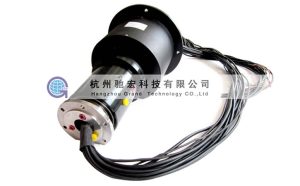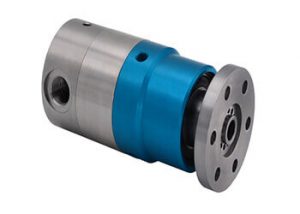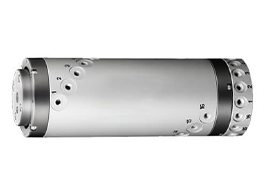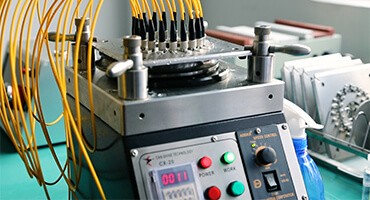Introduction
Our everyday lives are shaped and facilitated by numerous mechanical and technological innovations, most of which would cease to function without the intricate workings of vital components such as the Coolant Rotary Union. This seemingly small device plays an integral role not only in the cooling of machinery but also in ensuring the operations are carried out smoothly in various industrial applications.
In a world that thrives on efficiency and precision, the importance of a device that can transfer coolant from stationary components to rotating ones cannot be overstated. Such device plays a critical role in several industries, even more so in harsh, high-pressure, and high-speed environments where overheating could result in serious ramifications, leading to possible breakdowns or even safety issues. This essential and yet often overlooked component known as the Coolant Rotary Union is the focal point of our discussion in this article.
With an aim to provide an in-depth understanding of what exactly a Coolant Rotary Union is, we delve into its functionality, explore its various types, shed light on factors to consider for its selection, and offer insights on maintaining and troubleshooting these integral devices. And while Coolant Rotary Unions are largely prevalent, they aren’t the only solution. We also touch upon its alternatives, providing a robust view of options available out there.
So, whether you’re an engineer in the plastics or the printing industry, a technician in a manufacturing facility, or simply a curious mind with a thirst for knowledge about the machines that make our world go around – this comprehensive guide to Coolant Rotary Unions should prove enlightening and beneficial.
What Is the Coolant Rotary Union?
A Coolant rotary union also referred to as a coolant swivel or a rotary coupling, is a meticulously engineered device that finds use in facilitating the seamless transfer of coolant from a stationary to a rotating component within machinery.
In its essence, the primary function of a Coolant Rotary Union is to supply coolant (usually a flowing medium such as a liquid or gas) to mechanized equipment sections that are continuously in motion. This function is crucial in machinery where movement occurs at high speeds or under extreme pressure, factors that could lead to the machinery and its parts rapidly increasing in temperature and potentially overheating.
It’s critical to note that a Coolant Rotary Union is not a mere adaptor or a simple connector by any means. It’s a carefully crafted component designed to endure the substantial pressures of dynamic machinery components. It is built to prevent leakage of the coolant whilst managing the complex task of transferring this coolant under varying operational conditions, ranging from high rotational speed to high thermal and pressure differences.
The science and engineering behind a Coolant Rotary Union incorporate a sophisticated array of design aspects. These include distinctive sealing techniques and precise machining to ensure as minimal friction as possible during operation, ultimately increasing the longevity of the rotary union and the machinery it’s integrated within.
Therefore, a Coolant Rotary Union is more than just a crucial “go-between” linking a stationary and a turning part. It is an integral cog in the vast machine that is industry, playing an indispensable role in cooling high-powered, high-speed equipment, aiding in efficient operations, lengthening machinery lifetime, and minimizing potential downtime due to overheating-related issues.
Materials Used in Coolant Rotary Union
Selecting the right materials for the construction of Coolant Rotary Unions is essential to ensure their optimal performance, durability, and reliability under various operating conditions. The materials used in the construction of a Coolant Rotary Union are carefully chosen based on factors such as the type of coolant used, the pressure and temperature of operation, the nature of the industry, and the requirements of the specific application.
Below is an overview of the most common materials used in the construction of Coolant Rotary Unions:
Metal Components
Brass: Brass is often used for its corrosion resistance, machinability, and thermal conductivity properties. This makes it particularly suitable for lower pressure and temperature applications or less aggressive coolants.
Steel: With higher tensile strength than brass, steel is an economical option used in many moderate-pressure applications. Steel is usually coated or plated for corrosion resistance. However, the choice of steel depends on the corrosive nature of the coolant and the operating conditions.
Stainless Steel: Stainless steel is a popular choice for Coolant Rotary Unions due to its high corrosion resistance and strength. It’s used in applications with aggressive coolants or corrosive environments, such as in the chemical, food processing, or pharmaceutical industries.
Seal Materials
The seals used in a Coolant Rotary Union also play a vital role in preventing leakage and ensuring smooth operation. Material choice for seals depends on factors like coolant, pressure, and temperature. Some common seal materials include:
Viton (FKM): Viton is a fluoropolymer with excellent resistance to high temperatures, chemicals, and petroleum fluids. It is often used in applications where exposure to aggressive chemicals and high temperatures is expected.
PTFE (Polytetrafluoroethylene): PTFE has a low coefficient of friction, making it ideal for applications with high speeds and low wear. It also possesses great chemical resistance, making it appropriate for use with various coolants.
NBR (Nitrile Rubber): Nitrile rubber is an elastomer widely used in Coolant Rotary Unions for its excellent resistance to oils, fuels, and other chemicals. Its operational temperature range is typically between -30°C and 100°C.
Bearing Materials
Bearings in Coolant Rotary Unions facilitate smooth rotation. Choices for bearing materials are often made based on factors such as load capacity, friction coefficient, and resistance to chemicals and wear. Typical materials are steel, stainless steel, bronze, and ceramic materials.
By selecting the right combination of materials for both the body and internal components of a Coolant Rotary Union, manufacturers can produce a device capable of withstanding the diverse demands of countless applications while consistently delivering optimal performance and longevity.
Coolant Rotary Union Typical Application
Coolant Rotary Unions have broad applications across various industries due to their essential role in circulating coolant to rotating machinery components. Here are some typical applications:
Manufacturing
Coolant Rotary Unions are a staple in the manufacturing industry. They find use in CNC machines, lathes, milling machines, and more. The unions cool rotating components, preventing overheating, which can lead to machine failure or decreased precision in manufacturing.
Automotive

In the automotive industry, coolant rotary unions are critical in engine and transmission testing. They allow coolant to be supplied to rotating components to prevent overheating during testing processes. These unions are made robust enough to withstand the stringent demands of automotive testing environments.
Wind Energy

Modern wind turbines make use of high-powered generators which are prone to overheating. Coolant rotary unions provide cooling to these components and increase their efficiency. They can bear the high wind speeds and harsh environments often encountered in wind energy applications.
Oil and Gas

In the oil and gas industry, Coolant Rotary Unions find applications in mud motors used in drilling operations. They aid in cooling the rotating drill bit and allow drilling fluids to flow, facilitating the drilling process in harsh environments.
Printing and Paper Industries
Printing presses, paper machines, and laminating lines often incorporate Coolant Rotary Unions. They help to maintain the optimal temperatures of roller surfaces, ensuring high-quality printing or lamination.
Plastics Industry
Plastic molding machines have rotating components which can overheat during the molding process. Coolant Rotary Unions help maintain the temperature, ensuring smooth operations and consistent quality in product output.
In every industry they serve, Coolant Rotary Unions play a crucial role in enhancing operational efficiency, prolonging machinery life, and reducing downtime. They continue to be an essential part of the machinery that keeps our industrial world rotating.
Coolant Rotary Union Technical Specifications
When selecting a Coolant Rotary Union, it’s important to consider the technical specifications to ensure that the chosen rotary union meets the unique requirements of the given application. Here are some key technical specifications to consider:
Number of Passages
The number of coolant passages describes how many separate coolant channels are available within the rotary union. You may require multiple passages for different coolants or when simultaneous cooling of more than one component is needed. Make sure to carefully assess your application’s requirements.
Pressure
Each Coolant Rotary Union is specifically designed to withstand certain pressure levels. You need to determine the maximum pressure that your rotary union will be subjected to and select a model accordingly that can handle that pressure without any structural failure or leakage.
Temperature
The operational temperature range is a crucial consideration. Coolant Rotary Unions should be capable of operating within the temperature range of the coolant being used and the specific environmental conditions of the application. Choose a rotary union that is compatible with your system’s temperature requirements.
Flow Rate
The flow rate that the Coolant Rotary Union must accommodate is essential for optimal performance. Check your system’s required flow rate of the coolant and select a rotary union that can handle the specified flow capacity.
Connection Size and Type
Ensure that the connection size and type (e.g., flange, thread, etc.) of the Coolant Rotary Union match your machinery’s requirements. They must provide secure and leak-proof connections with the stationary and rotating components.
Seal and Bearing Material
As mentioned previously, the choice of seal and bearing materials is significant for the overall performance and life expectancy of the rotary union. Select the material based on the properties of the coolant, pressure, and temperature specific to your application.
Rotation Speed
Rotary unions must be capable of handling the rotational speed of the machinery components they are integrated with. Choose a union whose design can handle the maximum speed to ensure the union maintains structural integrity and optimal sealing.
It is essential to thoroughly evaluate your system requirements and consult manufacturers or experts for advice when selecting a Coolant Rotary Union, ensuring you find the best solution to meet your specific needs in terms of performance, reliability, and longevity.
Performance Requirements for Coolant Rotary Union
The effectiveness and efficiency of a Coolant Rotary Union are contingent upon the execution of several performance requirements. Meeting these key performance requirements ensures the longevity of both the Coolant Rotary Union and the machinery it is integrated with, as well as the smooth and safe execution of the processes in question.
Robust Design
Coolant Rotary Unions should be robustly designed to withstand varying physical and operational conditions, including high temperatures, pressures, and potential exposure to corrosive materials. Durability and resilience in the face of these conditions are important features in ensuring a reliable, long-lasting union.
Cooling Efficiency
The primary role of a Coolant Rotary Union is to aid in cooling components of a machine that is in operation. Hence, they must do this effectively to maintain proper operating temperatures and prevent potential overheating, which would lead to machinery damage and downtime.
Leakage and Friction Minimization
Sealing effectiveness is a key performance requirement. Preventing coolant leakage at the interface between stationary and rotating parts is critical for efficient operation and maintenance of the intended temperature levels. Minimizing friction at this interface also contributes to the rotary union’s longevity and performance.
Smooth and Continuous Operation
The ability to provide an uninterrupted flow of coolant is a vital performance requirement. To ensure this, Coolant Rotary Unions must operate seamlessly within the motion of the machinery while withstanding the conditions in which they are operating. The continuous operation also ensures that the machinery parts do not overheat and lead to potential damage.
Compatibility
Well-matched materials and designs for the specific operating conditions (coolant type, machine type, temperature, pressure, rotational speed, etc.) are essential performance requirements. Incorrect material choice can lead to corrosion, rapid wear and tear, or inadequate sealing and cooling.
Low Maintenance
A successful Coolant Rotary Union should require minimal maintenance. This reduces the time and cost associated with routine service checks or component replacements.
To ensure a Coolant Rotary Union satisfies all stated performance requirements, the manufacturer should conduct thorough design, testing, and quality control processes. Even after procurement, regular inspections and preventive maintenance are advisable to keep the device performing at its optimum.
Types of Coolant Rotary Union
Coolant Rotary Unions come in various designs, tailored to suit a wide range of applications and industries. While different designs may share common objectives such as facilitating coolant flow to rotating components, preventing leaks, and resisting wear, their configurations can vary greatly. Here are some common types of Coolant Rotary Unions:
Single-Passage Unions
Single-passage Coolant Rotary Unions have one internal passage and are best suited for applications with a single cooling channel requirement. This straightforward design is used in many industrial applications, including milling machines, lathes, and spindles.
Multiple-Passage Unions
Multiple-passage coolant Rotary Unions have two or more internal coolant channels, allowing for multiple simultaneous cooling operations or accommodating different types of coolants. Common applications include printing and paper machinery, plastic injection molding machines, and other specialized industrial equipment.
Coaxial (2-in-1 or 3-in-1) Unions
Coaxial Coolant Rotary Unions combine multiple independent passages in a single, compact design. They can cater to both fluid and air channels, creating a versatile solution for rotary applications that require air, coolant, or hydraulic oils. Industries such as automotive, textile, and aerospace utilize coaxial unions.
Monoflow and Duoflow Unions
Monoflow unions enable coolant to be supplied in one direction, usually through the stationary part of the rotary union to the rotating component. Duoflow unions, on the other hand, allow for the simultaneous flow of coolant from the rotating part to the stationary part, typically through separate channels. Depending on the exact application, either mono flow or duo flow design can be chosen based on factors like efficiency, space constraints, and leakage considerations.
High-Speed Unions
These Coolant Rotary Unions are designed explicitly for high-speed applications, often incorporating specialized materials and design features to minimize friction and wear, ensuring the union maintains a long operational life under such conditions.
Specialized Unions
Various specialized Coolant Rotary Unions cater to specific industries or applications. This can include designs that must withstand high pressures, corrosion-resistant materials for chemical or food processing industries, or explosion-proof models for the oil and gas sector.
When selecting a Coolant Rotary Union, it’s essential to consider the specific application’s requirements, including the number of passages, operating pressures, temperatures, and the type of coolant used. Consulting with manufacturers and industry professionals can ensure the best-suited Coolant Rotary Union type is chosen for a given application.
How to Choose Coolant Rotary Union?
Choosing the right Coolant Rotary Union for your application is crucial to ensure optimal performance, prolonged service life, and cost-effectiveness. Here are some steps to help guide your selection process:
Understand Your Application Requirements
Analyse and understand the operation that your rotary union will serve. This includes factors like the type and temperature of the coolant, rotational speed, the number of media channels needed, environmental conditions, and physical constraints.
Identify Key Technical Specifications
Reflect on the technical specifications your application will require:
- Flow Rate: Determine the required flow rate of the coolant for your process.
- Pressure: Calculate the maximum pressure the union will need to withstand.
- Temperature: Identify the operational temperature range based on the coolant’s temperature and the surrounding environment.
- Speed: Know the rotational speed of the parts where the rotary union will be installed.
- Size and Type of Connection: Recognize your system’s suitable connection size and type to ensure compatibility.
Choose the Type of Rotary Union
Based on the number of coolant passages required, select the type of Rotary Union:
- Single-Passage Rotary Union: Best for applications needing a single cooling channel.
- Multiple-Passage Rotary Union: Suitable for operations needing more than one coolant channel.
Depending on the directional flow requirement of the coolant, you might need to pick between Monoflow and Duoflow unions.
Consider Special Requirements
Apart from the usual considerations, there might be special needs applicable to your operation:
- Material Compatibility: If your coolant is corrosive, you might need a rotary union made from a material resistant to the coolant.
- High-Speed Operations: If your workflow involves high-speed rotating machinery, a Rotary Union designed to minimize friction and wear at high speeds would be best.
- Robustness: Depending on your workplace environment, you might need a more robust and durable design.
Consult Professionals or Manufacturers
Always seek professional help from manufacturers or industry professionals when deciding on the Coolant Rotary Union. They have thorough knowledge and experience in assessing your specific needs and can recommend the most suitable Rotary Union accordingly.
In conclusion, selecting a cool rotary union involves careful consideration of both your application requirements and the available technical specifications. Proper research, technical calculations, and professional consultation can greatly assist in making an informed choice.
Coolant Rotary Union Maintenance and Cleaning
Proper maintenance and cleaning of your Coolant Rotary Union play a critical role in its performance and service life. Below, we’ve provided some guidelines and tips for maintaining and cleaning your Coolant Rotary Union.
Regular Inspection
Frequent visual inspections for leaks or performance issues are the first line of defense. Visual clues such as coolant leaks or overheating parts can indicate potential problems with the rotary union.
Lubrication
The proper lubrication of a Coolant Rotary Union is crucial for maintaining its functionality over time. Review and follow the manufacturer’s suggested lubrication schedule and guidelines carefully.
Seal Replacement
Seals are vital components of rotary unions that prevent leaks and ensure proper functionality. Over time, seals wear down and may require replacement. Familiarize yourself with the signs of worn seals – such as leaks or pressure drops – and replace them promptly when required.
Regular Cleaning
Perform regular cleaning of the rotary union to prevent the buildup of dirt, dust, or grime that could create friction and wear. Remember to follow the manufacturer’s directions on cleaning to avoid harming the device.
Balancing and Alignment
To keep the union functioning efficiently, make sure it is properly balanced and aligned, particularly in applications involving high-speed rotation. Periodically check the alignment of the rotating components to prevent excess stress on the union and enlarge its lifespan.
Professional Maintenance and Repairs
For more complex maintenance tasks or if you encounter more severe problems, professional maintenance and repair services should be sought. It’s essential to choose a qualified technician experienced in your specific Coolant Rotary Union type.
Record Keeping
Good record-keeping helps track the maintenance history of your Coolant Rotary Union, making it easier to anticipate potential issues and recognize when the unit may be nearing the end of its operational life.
Compliance with Manufacturer Instructions
Always follow the manufacturer’s instructions for maintenance, repairs, and operation. Understanding and following these guidelines can prevent many common issues that may compromise the performance of your Coolant Rotary Union.
Regular rotary union maintenance isn’t just about cleaning and inspecting; it involves preventive and corrective maintenance tasks that can dramatically extend the life cycle of the device, make operations more efficient, reduce waste, improve safety, and cut costs.
Alternatives to Coolant Rotary Union
While Coolant Rotary Unions are widely utilized across various industries due to their ability to provide reliable coolant transmission in rotating machinery, some alternatives might better suit certain specific applications. Here are a few alternatives to a Coolant Rotary Union:
Swivel Joints
Swivel joints function similarly to rotary unions, allowing the transfer of fluid under pressure or vacuum from stationary inlets to rotating outlets. They’re used in applications where full 360-degree rotation is required, but they are typically limited to larger, less precise applications due to their larger physical dimensions.
Rotating Unions with Integrated Electric Slips Rings
In some applications where both fluid (coolant) and electrical power need to be transmitted to rotating machinery, a combined unit of a rotary union and an electrical slip ring might be used. The integrated design reduces overall system complexity and installation costs.
Hydraulic Rotary Unions

For applications that require the transfer of hydraulic fluid, a Hydraulic Rotary Union might be a more suitable choice. They are designed to withstand larger pressures and are often employed in heavy-duty applications such as excavators and drilling rigs.
Pneumatic Rotary Unions

Pneumatic Rotary Unions are used in applications that require the transfer of pressurized air instead of liquid coolant. They’re often utilized in pneumatic systems in various sectors, including automotive, aerospace, and manufacturing.
Heat Pipes
In specific applications, especially when dealing with electronic components, heat pipes might be preferred. Heat pipes are devices that transfer heat passively via phase transition to cool various electronic components like CPUs.
Quick Disconnects (QDs)
Quick Disconnects, or QDs, provide a fast and easy way to connect and disconnect fluid lines. Though QDs don’t allow for continuous rotation, they are better suited for applications where periodic connection and disconnection are required.
Choosing an alternative to a Coolant Rotary Union will depend entirely on your specific application requirements. Consulting with an engineer or professional can guide you toward the right selection.
Causes of Coolant Rotary Union Failure
While Coolant Rotary Unions are robust and reliable devices, they can fail due to a variety of reasons. Here are some common causes of Coolant Rotary Union failure:
Insufficient Lubrication
Proper lubrication is vital for the optimum operation of rotary unions. Lack of sufficient lubrication can lead to increased friction, causing wear and tear, and consequently, device failure.
Improper Installation
Incorrect installation of the rotary union can lead to operating issues and premature failure. This can include misalignment, incorrect tightening of connections, and improper sizing.
Seal Wear or Failure
The seals inside a Rotary Union bear the brunt of the operational stress. Seal failure, typically caused by wear and tear, harsh operating conditions, or the use of incorrect seal materials, can lead to fluid leaks and union failure.
Exceeding Operating Parameters
Subjecting a rotary union to operating parameters beyond its designed limits – such as temperature, pressure, or rotational speed – can lead to multiple forms of failure.
Contamination
Contamination of the coolant or the operating environment can lead to internal blockages, increased wear on the seals, or corrosion of the union’s components, leading to its failure.
Lack of Maintenance
Regular maintenance, including cleaning, inspection, lubrication, and seal replacement, is crucial to extend the lifespan of a Rotary Union. A lapse in maintenance can result in different forms of failure.
Improper Use
Using the Rotary Union for applications beyond its design or recommended usage can lead to premature failure.
Understanding these common causes of Coolant Rotary Union failure allows for better prevention measures and helps in diagnosing any issues that might occur with your rotary union. Periodic inspections, timely maintenance, and adherence to recommended operation guidelines can prevent most failures.
Conclusion
Coolant Rotary Unions are integral components in numerous industries, owing to their ability to provide continuous, reliable transmission of coolant in rotating machinery. Selecting the right rotary union heavily depends on understanding the specifics of your application, including the flow rate, operating pressure, temperature, rotational speed, and the type of connections required. Different types of rotary unions, including single-passage and multiple-passage rotary unions, exist for various applications. For some applications, different types of rotary unions or alternative devices such as swivel joints, hydraulic or pneumatic rotary unions, and heat pipes can be used.
In terms of maintenance, routine inspection, regular lubrication, seal replacement, and timely cleaning are key. Balancing and alignment equally contribute to the efficiency and lifespan of rotary unions. For more complicated maintenance tasks and troubleshooting, professional services should be leveraged.
Despite the robust and reliable design of coolant rotary unions, they can fail due to a range of factors, such as insufficient lubrication, improper installation, seal wear or failure, exceeding operating parameters, contamination, lack of maintenance, and improper use. Understanding these common causes of failure allows for preventive measures and timely diagnosis and repair.
Overall, the selection, maintenance, understanding of potential alternatives, and awareness of factors causing failure all contribute to optimizing the use of coolant rotary unions. They play an invaluable role in myriad applications and sectors, enabling efficient and consistent operations. By taking the necessary precautions and maintaining proper usage, you can ensure longevity and the smooth running of your machinery.
FAQ About Coolant Rotary Union
Q: What is the main function of a Coolant Rotary Union?
A: The main function of a Coolant Rotary Union is to transfer coolant from a stationary component to a rotating component within machinery, often working under high pressure and high-speed conditions.
Q: Can I use any coolant with a Coolant Rotary Union?
A: The selection of coolant depends on many factors such as the compatibility with the machine materials, the operating temperature, and the pressure. Always consult with a professional or manufacturer before choosing the coolant.
Q: How often should I perform maintenance on my Coolant Rotary Union?
A: The maintenance frequency of your Coolant Rotary Union depends on the usage and your operational conditions. Regular inspection for wear, cleaning, and lubricating are recommended. Check with your manufacturer for specific maintenance guidelines.


